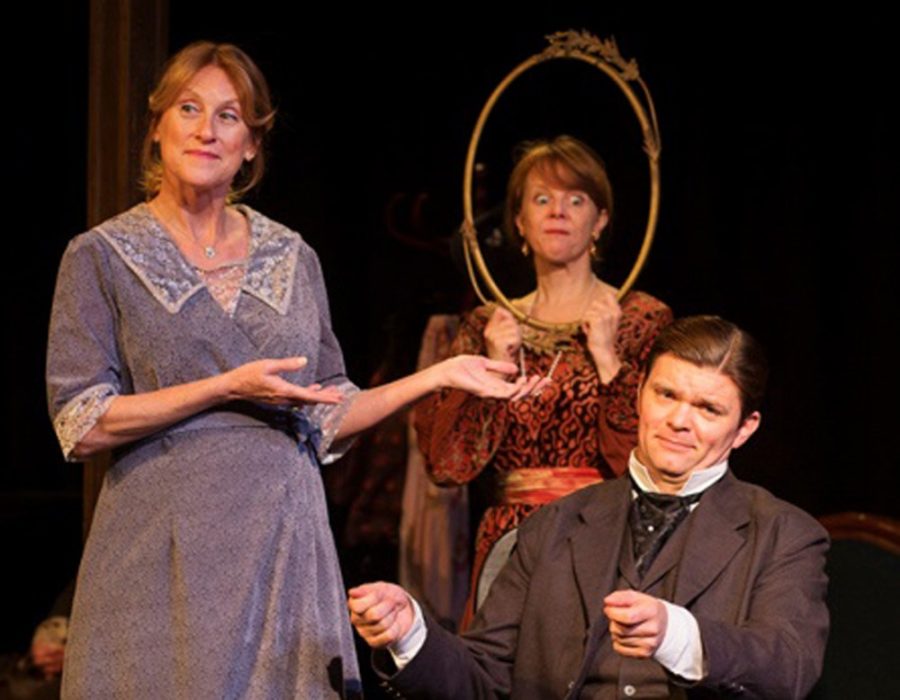From start to finish and in every detail, The Rogue Theatre’s original production of “The Lady in the Looking Glass: A Concert of Seven Stories by Virginia Woolf” exemplifies the cohesion and fluidity essential in ensemble theatre.
The Rogue Theatre co-founder, actress and costume designer Cynthia Meier took on the difficult task of adapting Virginia Woolf’s punctuation and illustration-heavy literary work for the stage and proved she was equal to the challenge.
Woolf could dig into the fractional moments in one’s life and put words to the analytical and emotional meltdown, playing into the spiral of one’s internal monologue with humor and palpable depth.
The seven actors comprising the seven stories all exhibited precision in regards to timing and more than proved why each were chosen for this challenging production. If one actor were to have been out of sync, the environment of each carefully crafted story of the seven vignettes would have fissures of the seeping modern world.
Structured similarly as Dylan Thomas’ “Under Milk Wood,” the actors remained on stage for the duration of the play as characters alternated in breaking the fourth wall to provide narration.
“It’s a modernist thing,” Rogue Theatre artistic director Joseph McGrath said. “You just let it wash over you.”
At times, the rapidity at which the characters speak is difficult to keep up with — but not impossible, or without purpose. Though modern in style, the show is intellectual but accessible and will absorb audiences into the storytelling process.
UA theatre major Connor Foster, in his fifth production with The Rogue Theatre, displayed maturity in his craft and ease in convincingly portraying an early-20th century man.
It is difficult to single out actors in phenomenal ensembles, as each elevates the other’s performance without showboating their own, but one actress received an impromptu round of applause for her vulnerability.
Patty Gallagher’s Mabel, a woman attending a fashionable high-society evening party in a dress she suddenly feels wretchedly ashamed of, is the early 20th century version of the jungle that is the high school cafeteria.
Mabel pours out her insecurities of never believing she is enough as Charles Zoll, the onstage pianist, deftly plays Frédéric Chopin’s “Nocturne Op. 9 No. 1,” without manipulating emotion from the audience. If anything, Zoll provides the music Mabel’s heart senses as she realizes no dress can heal the wounds beneath the surface.
Gallagher’s performance in “The New Dress” led many in the audience to admit after the show that it had awoken unpleasant memories often difficult to put into words.
This was a feeling Woolf knew all too well and wrote of frequently, and it was masterfully captured throughout her selection of stories that were brought to life.
Theatrical lighting is considered a success when it isn’t pointed out but absorbs into the play. During the absurdly funny “The Mark on the Wall,” two actors spiral into an over-analysis of historical and philosophical comparisons to understand the purpose of the smudge on a wall. As the actors pretended to light a fire, their faces glowed from a reflection of the non-existent fireplace, adding to the production’s magic.
Each story smoothly transitions between humorous and thought-provoking stories as the actors elegantly move around the stage.
Even a moment as simple as a couple’s kiss while Claude Debussy’s “Clair de Lune” played on outshines any kiss in “The Notebook.”
This production doesn’t end after the actors take their bows. It is entertaining as well as enlightening, and not just because of the beautiful turn of phrases like “iron bullets of the moon.”
In the words of Virginia Woolf, “the sky veils her stars; then bares them.” Seven of these bared stars perform at The Rogue Theatre until March 15.
_______________
Follow Anna Mae Ludlum on Twitter.









